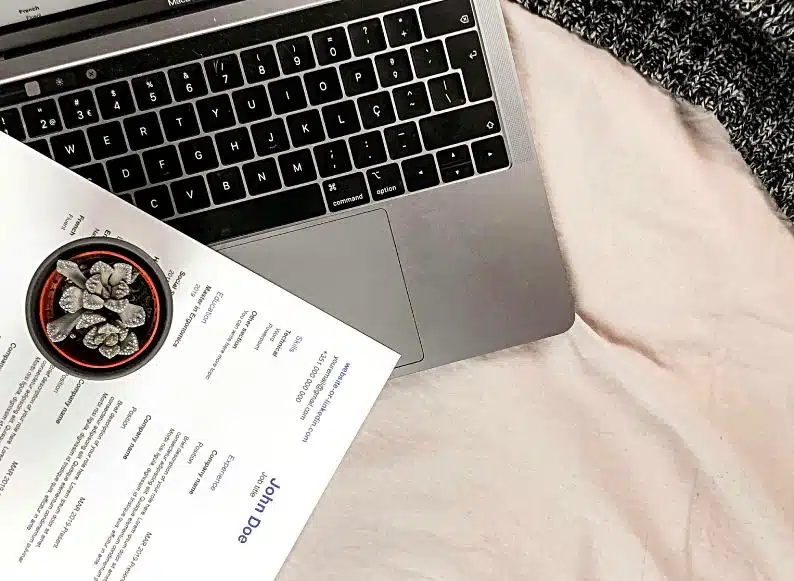words Alexa Wang
The first thing recruiters and employers notice is your bio. Based on what it looks like and what it contains, they determine whether you fit the requirements of the job posting. So, even if you are the world’s greatest and most qualified candidate, no one will ever know if you make a mistake on this crucial first step.
If you want to avoid that (and I assume that you do), let’s look at what you need to do to write a strong professional bio.
Source: Unsplash
Choose the right design
Selecting the design is the first step. Most of the time, it doesn’t have to be anything exceptional or one-of-a-kind. Numerous websites even let you download templates and customize them to fit your needs.
Here are a couple of pointers:
- Avoid designs with too many visual elements or colors, as they’re often distracting;
- Select a font that is readable and stick to the same one throughout the bio;
- Pay attention to the alignment so that it’s easy to skim through without appearing chaotic.
For some jobs, these guidelines don’t necessarily apply. If you’re applying for a job as a web or graphic designer, you can use your CV to showcase your skills, expertise, and creativity. To do that, you can play with some of these rules.
You can find some short professional bio examples on various websites, if you wish to get some ideas.
Work on the introduction section
Your first and last name, your title, your contact information, and an “about me” section are typically included in the bio’s introductory section.
After writing your first and last name, you’ll need to add your title. It’s not necessary for the title to match your previous one. In fact, it’s occasionally preferable to use the title that most closely matches the job posting’s title. This is particularly the case if the company where you are applying for a job uses an ATS (Applicant Tracking System) to filter resumes.
Regarding the “about me” part, while not required, having one doesn’t hurt. Before going into further detail in the rest of your bio, you can use this area to highlight some of your most important abilities and prior work experience.
Also, keep in mind that in some countries, it’s customary to have a photo in your bio, while in others, it’s strictly forbidden.
List your previous work experience
The first section after the introduction should be dedicated to your previous work experiences.
Always start this section by listing your most recent experience. Experience from the previous two to three years is typically the most significant one. More senior or managerial positions are an exception, as they typically require over five years of experience.
It’s also not necessary to list every experience. It’s advisable to keep your resume simple and only include relevant employment experience. You can determine what is and isn’t relevant based on the job description.
Another important note – you can tweak your own experience to match the job description. Of course, you should never lie on your resume – sooner or later, someone will bust you. However, you can choose a similar wording as the one used in the job posting.
Write down your latest projects
The “latest projects” section is a great addition. Of course, not every profession involves projects in their true meaning, but almost everyone has worked on some large, challenging assignments.
For example, if you are a restaurant manager and have managed a restaurant renovation, you should include that in your resume along with further information about your contribution to the project and the obstacles you successfully overcame.
Ideally, it’ best to think of two or three projects that demonstrate your skills and fit the job description.
Add skills
While the “skills” section is one of those sections that doesn’t contain any additional explanation, it’s still important to have one.
The main reason this section is necessary often comes down to ATS. ATS is often used by recruiters to screen resumes in cases where there’s a high volume of applications. To help the ATS identify which CVs are the closest matches, they employ keywords. Many of these keywords are skills, so it comes in handy to have them all in one spot.
You may also use this section to list the tools you used in the past or even programming languages (if you’re a software developer).
List your education and certification
Finally, you should provide details about your education and any certificates you may have. This section might not be the most essential one for some roles, while the situation might be entirely different for others.
For example, if the job ad mentions candidates must have a specific degree or certification to perform the job, you definitely won’t be invited for an interview if your CV doesn’t state you match those requirements.
However, even when this isn’t the case, listing your most recent degree and certifications is still beneficial.
To sum up, it’s essential to pay attention to detail in every section of your bio. Each part plays a crucial role in presenting yourself effectively to potential employers. By following these guidelines and ensuring your resume is well-defined and tailored to the job requirements, you significantly improve your chances of making a strong impression and landing the opportunities you desire in your career journey.





